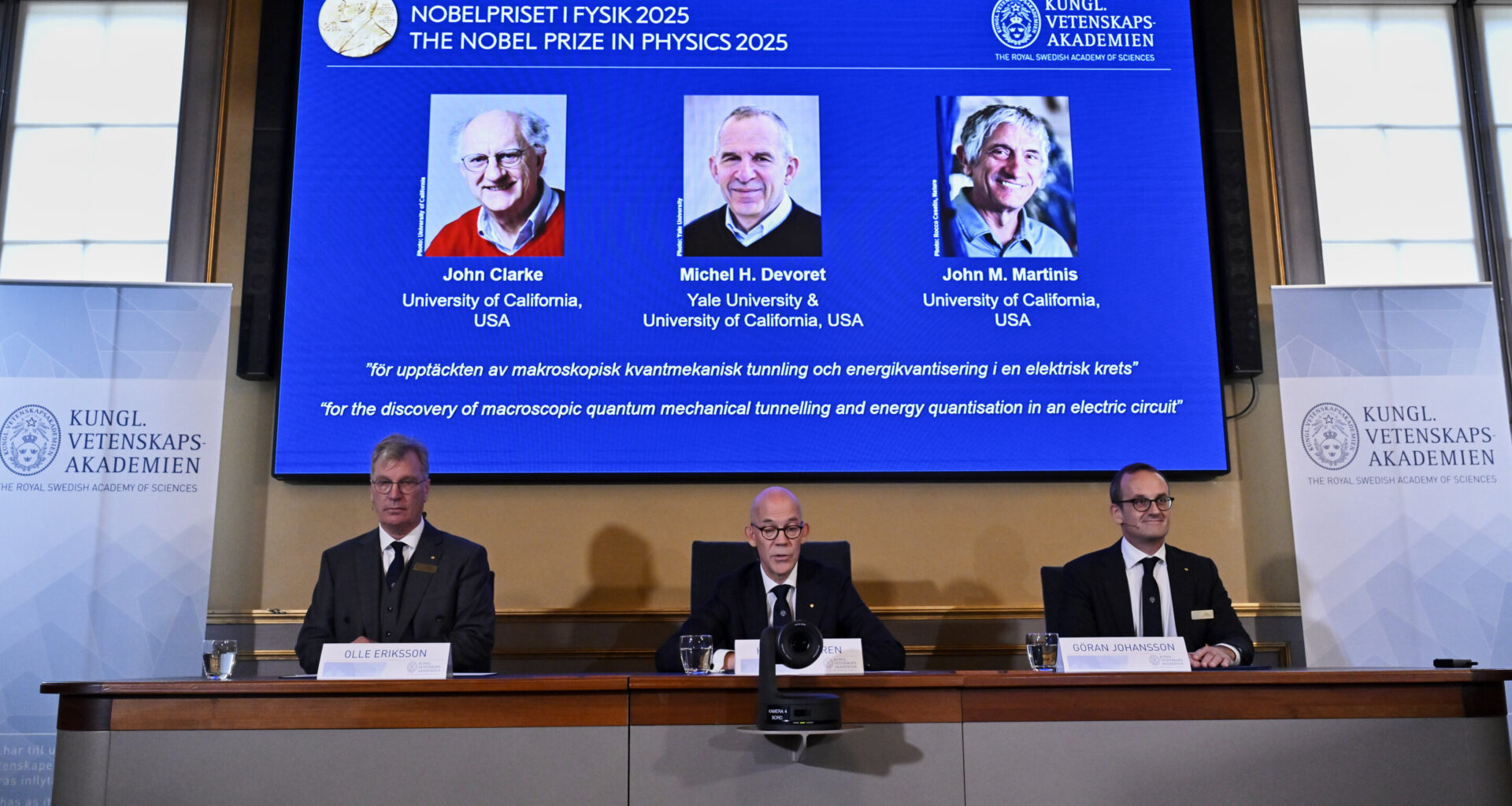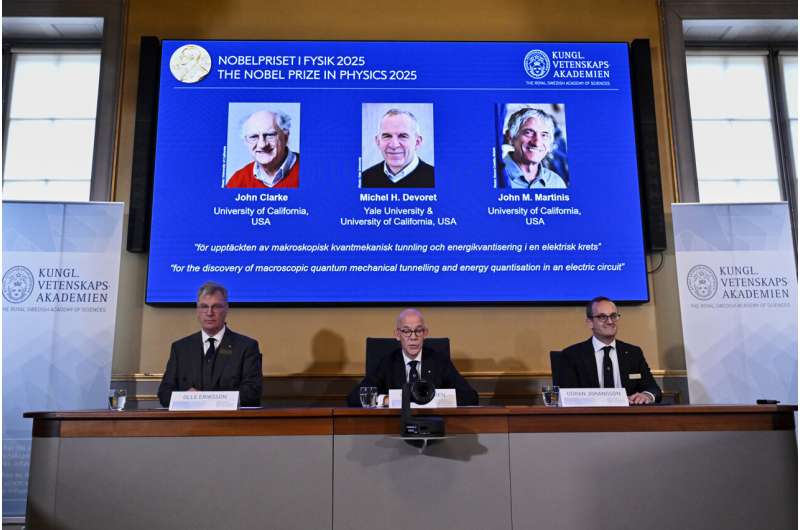
From left, Chair of the Nobel Committee for Physics Chair Olle Eriksson, Secretary General of the Swedish Academy of Sciences Hans Ellegren and Member of the Nobel Committee for Physics Goran Johansson announce John Clarke, Michel H Devoret and John M. Martinis, on screen behind, as the recipients the Nobel Prize in Physics, at the Nobel Assembly of the Karolinska Institutet, in Stockholm, Sweden, Tuesday, Oct. 7, 2025. Credit: Christine Olsson/TT News Agency via AP
Three scientists won the Nobel Prize in physics Tuesday for research on the strange behavior of subatomic particles called quantum tunneling that enabled the ultra-sensitive measurements achieved by MRI machines and laid the groundwork for better cellphones and faster computers.
The work by John Clarke, Michel H. Devoret and John M. Martinis, who work at American universities, took the seeming contradictions of the subatomic world—where light can be both a wave and a particle and parts of atoms can tunnel through seemingly impenetrable barriers—and applied them in the more traditional physics of digital devices. The results of their findings are just starting to appear in advanced technology and could pave the way for the development of supercharged computing.
The prizewinning research in the mid-1980s took the subatomic “weirdness of quantum mechanics” and found how those tiny interactions can have real-world applications, said Jonathan Bagger, CEO of the American Physical Society. The experiments were a crucial building block in the fast-developing world of quantum mechanics.
Speaking from his cellphone, Clarke, who spearheaded the research team, said, “One of the underlying reasons that cellphones work is because of all this work.”
When quantum mechanics first came to light in 1926, a prominent physicist sought to illustrate its many paradoxes with the example of a cat in a box that was both alive and dead at the same time. The three Nobel winners showed that science can put such principles to work, said Physics Today Editor-in-Chief Richard Fitzgerald, who was in a competing research group in the 1990s.
“They didn’t take it that far, but they showed that it can be done,” Fitzgerald said.
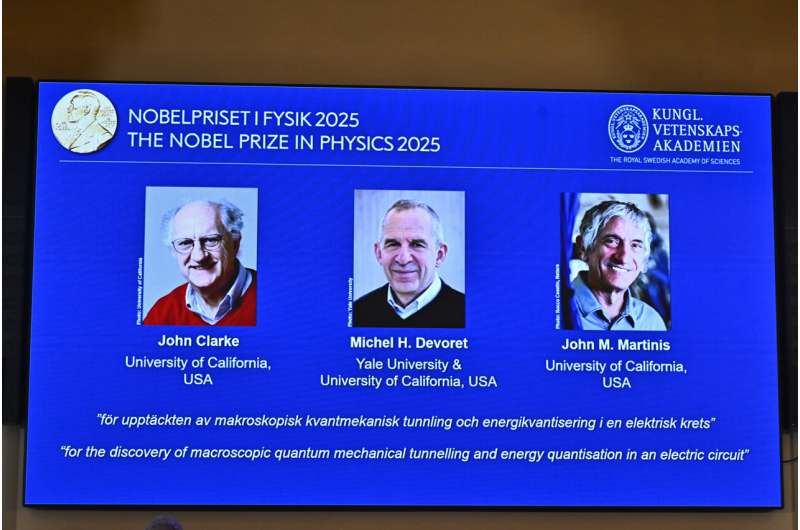
Photos of John Clarke, Michel H Devoret and John M. Martinis are pictured on a screen after they were announced as winners of the Nobel Prize in Physics, at the Nobel Assembly of the Karolinska Institutet, in Stockholm, Sweden, Tuesday, Oct. 7, 2025. Credit: Christine Olsson/TT News Agency via AP
The winning physicists took “the scale of something that we can’t see, we can’t touch, we can’t feel” and brought it “up to the scale of something recognizable” and made it “something you can build upon,” Fitzgerald said.
Clarke, 83, conducted his research at the University of California, Berkeley. Martinis, 67, worked at the University of California, Santa Barbara. Devoret, 72, is at Yale and also at the University of California, Santa Barbara.
How the winners reacted
Martinis’ wife, Jean, told Associated Press reporters who called at his home hours after the announcement that he was still asleep and did not yet know. In the past, she said, they stayed up on the night of the physics award, but at some point they decided that sleep was more important.
When his wife woke him and told him about the journalists seeking an interview, the new Nobel laureate remembered that the prizes were being announced this week. He opened his computer, looked at the announcement and saw his picture along with the other winners.
“So I was kind of in shock,” he said.
Clarke said it never occurred to him that he would win a Nobel Prize.
“I practically collapsed,” Clarke told AP. “I was completely stunned. I mean, it’s something that I had never, ever dreamed of in my entire life.”
Why the work matters
Martinis—who was a senior Google scientist working toward quantum computing before co-founding his own company, Qolab—said the big future goal is quantum computing, which would be a giant leap in speed and sophistication by relying on the power of the contradictory states in that subatomic world.
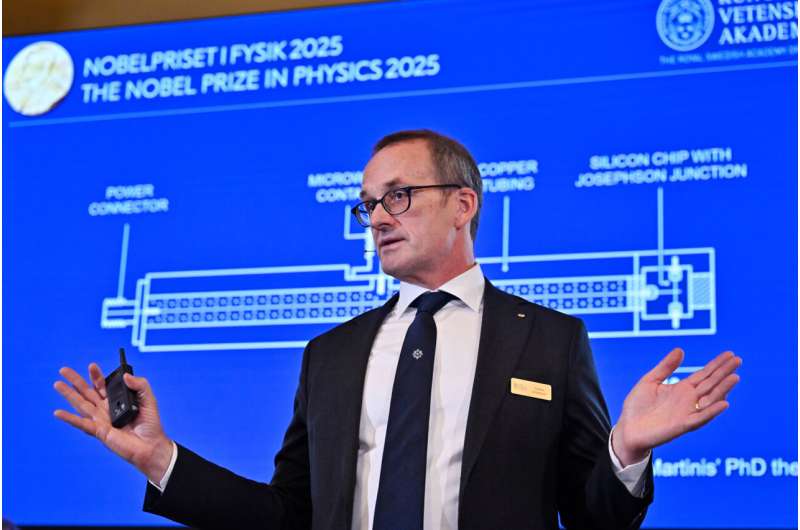
Member of the Nobel Committee for Physics Goran Johansson explains this year’s Nobel Prize in Physics, awarded to John Clarke, Michel H Devoret and John M. Martinis, at the Nobel Assembly of the Karolinska Institutet, in Stockholm, Sweden, Tuesday, Oct. 7, 2025. Credit: Christine Olsson/TT News Agency via AP
That is still eight to 10 years away. But he said the team’s experiments showed “a computer could be much, much more powerful.”
Devoret is now chief scientist for Google’s quantum computing efforts.
Quantum computers are “one very sort of obvious use,” but the research could also help develop sensors that detect and measure faint phenomena, such as magnetic fields, and advance cryptography to encode information, said Mark Pearce, a professor of astrophysics and Nobel physics committee member.
Discover the latest in science, tech, and space with over 100,000 subscribers who rely on Phys.org for daily insights.
Sign up for our free newsletter and get updates on breakthroughs,
innovations, and research that matter—daily or weekly.
And through better understanding of precision chemistry, it could develop better materials for daily living and even give an added boost to artificial intelligence, Martinis said.
Before the work at Berkeley, scientists knew single electrons or pairs of tiny electrons could tunnel through an impenetrable barrier. What Clarke said his team learned was “if you design the circuity properly, you could actually have tunneling” of objects larger and more useful than just a couple of electrons.
That discovery “can be used to make very sophisticated things that would not otherwise be able to work out,” Clarke said at a news conference, mentioning his iPhone and quantum computers.
He also criticized the Trump administration for its deep cuts to science funding, saying they would “cripple science.”
“If this continues … it may take a decade to get back to where we were half a year ago,” Clarke said.
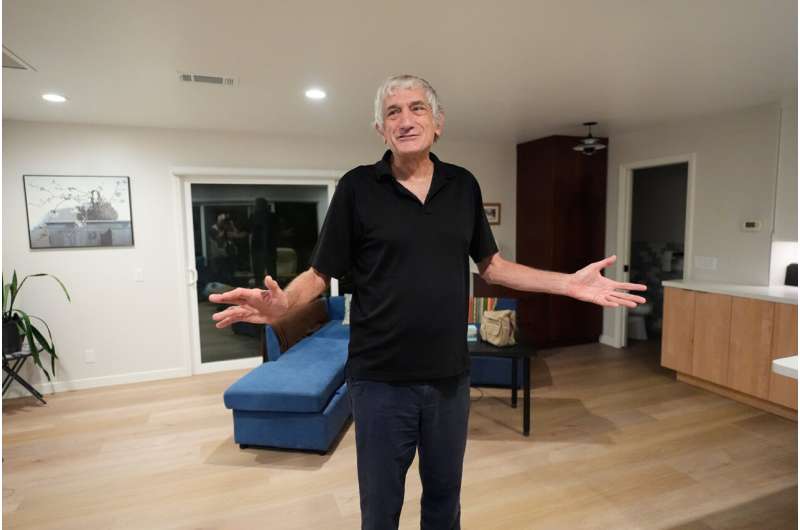
John Martinis stands in his living room after winning the Nobel Prize in Physics for his work on quantum tunneling on Tuesday, Oct. 7, 2025, in Santa Barbara, Calif. Credit: AP Photo/Mark J. Terrill
Martinis, Bagger and Fitzgerald said it’s a bit of a stretch to say cellphones now use the breakthrough made by Clarke and colleagues. But ultra-sensitive measuring devices rely on the team’s work, including MRI machines, which would be far less useful without their advances, Bagger said.
“Quantum mechanics is everywhere in everything we do, from the cellphone to the satellite communications that are connected to the cellphones, to the screens on which we watch our videos on our cellphones,” Bagger said.
Nobel history and other 2025 prizes
Tuesday’s award was the 119th time the prize has been given. Last year, artificial intelligence pioneers John Hopfield and Geoffrey Hinton won the physics prize for helping create the building blocks of machine learning.
On Monday, Mary E. Brunkow, Fred Ramsdell and Dr. Shimon Sakaguchi won the Nobel Prize in medicine on Monday for discoveries about how the immune system knows to attack germs and not our bodies.
Nobel announcements continue with the chemistry prize on Wednesday and literature on Thursday. The Nobel Peace Prize will be announced Friday followed by the Nobel Memorial Prize in economics on Monday.
The award ceremony will be held Dec. 10, the anniversary of the 1896 death of Alfred Nobel, the wealthy Swedish industrialist and the inventor of dynamite who founded the prizes.
The prizes carry priceless prestige and a cash award of 11 million Swedish kronor (nearly $1.2 million).
Nobel committee announcement:
The Royal Swedish Academy of Sciences has decided to award the Nobel Prize in Physics 2025 to
John Clarke, University of California, Berkeley, U.S.
Michel H. Devoret, Yale University, New Haven, CT and University of California, Santa Barbara, U.S.
John M. Martinis, University of California, Santa Barbara, U.S.
“for the discovery of macroscopic quantum mechanical tunnelling and energy quantisation in an electric circuit”
Their experiments on a chip revealed quantum physics in action
A major question in physics is the maximum size of a system that can demonstrate quantum mechanical effects. This year’s Nobel Prize laureates conducted experiments with an electrical circuit in which they demonstrated both quantum mechanical tunnelling and quantised energy levels in a system big enough to be held in the hand.
Quantum mechanics allows a particle to move straight through a barrier, using a process called tunnelling. As soon as large numbers of particles are involved, quantum mechanical effects usually become insignificant. The laureates’ experiments demonstrated that quantum mechanical properties can be made concrete on a macroscopic scale.
In 1984 and 1985, John Clarke, Michel H. Devoret and John M. Martinis conducted a series of experiments with an electronic circuit built of superconductors, components that can conduct a current with no electrical resistance. In the circuit, the superconducting components were separated by a thin layer of non-conductive material, a setup known as a Josephson junction. By refining and measuring all the various properties of their circuit, they were able to control and explore the phenomena that arose when they passed a current through it. Together, the charged particles moving through the superconductor comprised a system that behaved as if they were a single particle that filled the entire circuit.
This macroscopic particle-like system is initially in a state in which current flows without any voltage. The system is trapped in this state, as if behind a barrier that it cannot cross. In the experiment the system shows its quantum character by managing to escape the zero-voltage state through tunnelling. The system’s changed state is detected through the appearance of a voltage.
The laureates could also demonstrate that the system behaves in the manner predicted by quantum mechanics—it is quantised, meaning that it only absorbs or emits specific amounts of energy.
“It is wonderful to be able to celebrate the way that century-old quantum mechanics continually offers new surprises. It is also enormously useful, as quantum mechanics is the foundation of all digital technology,” says Olle Eriksson, Chair of the Nobel Committee for Physics.
The transistors in computer microchips are one example of the established quantum technology that surrounds us. This year’s Nobel Prize in Physics has provided opportunities for developing the next generation of quantum technology, including quantum cryptography, quantum computers, and quantum sensors.
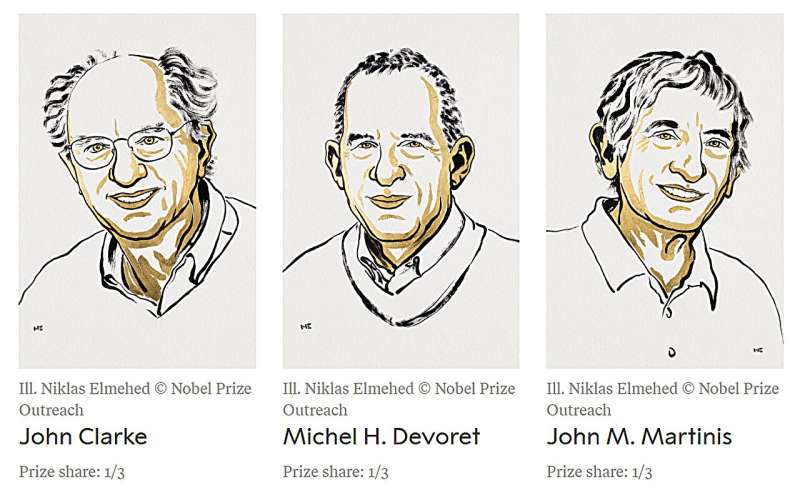
Credit: Nobel committee
Quantum properties on a human scale
The Nobel Prize laureates in physics for 2025, John Clarke, Michel H. Devoret and John M. Martinis, used a series of experiments to demonstrate that the bizarre properties of the quantum world can be made concrete in a system big enough to be held in the hand. Their superconducting electrical system could tunnel from one state to another, as if it were passing straight through a wall. They also showed that the system absorbed and emitted energy in doses of specific sizes, just as predicted by quantum mechanics.
A series of groundbreaking experiments
Quantum mechanics describes properties that are significant on a scale that involves single particles. In quantum physics, these phenomena are called microscopic, even when they are much smaller than can be seen using an optical microscope. This contrasts with macroscopic phenomena, which consist of a large number of particles. For example, an everyday ball is built up of an astronomical amount of molecules and displays no quantum mechanical effects. We know that the ball will bounce back every time it is thrown at a wall. A single particle, however, will sometimes pass straight through an equivalent barrier in its microscopic world and appear on the other side. This quantum mechanical phenomenon is called tunnelling.
This year’s Nobel Prize in Physics recognises experiments that demonstrated how quantum tunnelling can be observed on a macroscopic scale, involving many particles. In 1984 and 1985, John Clarke, Michel Devoret and John Martinis conducted a series of experiments at the University of California, Berkeley. They built an electrical circuit with two superconductors, components that can conduct a current without any electrical resistance. They separated these with a thin layer of material that did not conduct any current at all. In this experiment, they showed that they could control and investigate a phenomenon in which all the charged particles in the superconductor behave in unison, as if they are a single particle that fills the entire circuit.
This particle-like system is trapped in a state in which current flows without any voltage—a state from which it does not have enough energy to escape. In the experiment, the system shows its quantum character by using tunnelling to escape the zero-voltage state, generating an electrical voltage. The laureates were also able to show that the system is quantised, which means it only absorbs or emits energy in specific amounts.
Tunnels and crossings
To help them, the laureates had concepts and experimental tools that had been developed over decades. Together with the theory of relativity, quantum physics is the foundation of what has come to be called modern physics, and researchers have spent the last century exploring what it entails.
Individual particles’ ability to tunnel is well known. In 1928, the physicist George Gamow realised that tunnelling is the reason why some heavy atomic nuclei tend to decay in a particular manner. The interaction between the forces in the nucleus creates a barrier around it, holding in the particles it contains. However, despite this, a small piece of the atomic nucleus can sometimes split off, move outside the barrier and escape—leaving behind a nucleus that has been transformed into another element. Without tunnelling, this type of nuclear decay could not occur.
Tunnelling is a quantum mechanical process, which entails that chance plays a role. Some types of atomic nuclei have a tall, wide barrier, so it can take a long while for a piece of the nucleus to appear outside it, while other types decay more easily. If we only look at a single atom, we cannot predict when this will happen, but by watching the decay of a large number of nuclei of the same type, we can measure an expected time before tunnelling occurs. The most common way of describing this is through the concept of half-life, which is how long it takes for half the nuclei in a sample to decay.
Physicists were quick to wonder whether it would be possible to investigate a type of tunnelling that involves more than one particle at a time. One approach to new types of experiments originated in a phenomenon that arises when some materials get extremely cold.
In an ordinary conductive material, current flows because there are electrons that are free to move through the entire material. In some materials, the individual electrons that push their way through the conductor may become organised, forming a synchronised dance that flows without any resistance. The material has become a superconductor and the electrons are joined together as pairs. These are called Cooper pairs, after Leon Cooper who, along with John Bardeen and Robert Schrieffer, provided a detailed description of how superconductors work (Nobel Prize in Physics 1972).
Cooper pairs behave completely differently to ordinary electrons. Electrons have a great deal of integrity and like to stay at a distance from each other—two electrons cannot be in the same place if they have the same properties. We can see this in an atom, for example, where the electrons divide themselves into different energy levels, called shells. However, when the electrons in a superconductor join up as pairs, they lose a bit of their individuality; while two separate electrons are always distinct, two Cooper pairs can be exactly the same. This means the Cooper pairs in a superconductor can be described as a single unit, one quantum mechanical system. In the language of quantum mechanics, they are then described as a single wave function. This wave function describes the probability of observing the system in a given state and with given properties.
If two superconductors are joined together with a thin insulating barrier between them, it creates a Josephson junction. This component is named after Brian Josephson, who performed quantum mechanical calculations for the junction. He discovered that interesting phenomena arise when the wave functions on each side of the junction are considered (Nobel Prize in Physics 1973). The Josephson junction rapidly found areas of application, including in precise measurements of fundamental physical constants and magnetic fields.
The construction also provided tools for exploring the fundamentals of quantum physics in a new way. One person who did so was Anthony Leggett (Nobel Prize in Physics 2003), whose theoretical work on macroscopic quantum tunnelling at a Josephson junction inspired new types of experiments.
The research group starts its work
These subjects were a perfect match for John Clarke’s research interests. He was a professor at the University of California, Berkeley, in the US, where he had moved after completing his doctoral degree at the University of Cambridge, UK, in 1968. At UC Berkeley he built up his research group and specialised in exploring a range of phenomena using superconductors and the Josephson junction.
By the mid-1980s, Michel Devoret had joined John Clarke’s research group as a postdoc, after receiving his doctorate in Paris. This group also included the doctoral student John Martinis. Together, they took on the challenge of demonstrating macroscopic quantum tunnelling. Vast amounts of care and precision were necessary to screen the experimental setup from all the interference that could affect it. They succeeded in refining and measuring all the properties of their electrical circuit, allowing them to understand it in detail.
To measure the quantum phenomena, they fed a weak current into the Josephson junction and measured the voltage, which is related to the electrical resistance in the circuit. The voltage over the Josephson junction was initially zero, as expected. This is because the wave function for the system is enclosed in a state that does not allow a voltage to arise. Then they studied how long it took for the system to tunnel out of this state, causing a voltage. Because quantum mechanics entails an element of chance, they took numerous measurements and plotted their results as graphs, from which they could read the duration of the zero-voltage state. This is similar to how measurements of the half-lives of atomic nuclei are based on statistics of numerous instances of decay.
The tunnelling demonstrates how the experimental setup’s Cooper pairs, in their synchronised dance, behave like a single giant particle. The researchers obtained further confirmation of this when they saw that the system had quantised energy levels. Quantum mechanics was named after the observation that the energy in microscopic processes is divided into separate packages, quanta. The laureates introduced microwaves of varying wavelengths into the zero-voltage state. Some of these were absorbed, and the system then moved to a higher energy level. This showed that the zero-voltage state had a shorter duration when the system contained more energy—which is exactly what quantum mechanics predicts. A microscopic particle shut behind a barrier functions in the same way.
Practical and theoretical benefit
This experiment has consequences for the understanding of quantum mechanics. Other types of quantum mechanical effects that are demonstrated on the macroscopic scale are composed of many tiny individual pieces and their separate quantum properties. The microscopic components are then combined to cause macroscopic phenomena such as lasers, superconductors and superfluid liquids. However, this experiment instead created a macroscopic effect—a measurable voltage—from a state that is in itself macroscopic, in the form of a common wave function for vast numbers of particles.
Theorists like Anthony Leggett have compared the laureates’ macroscopic quantum system with Erwin Schrödinger’s famous thought experiment featuring a cat in a box, where the cat would be both alive and dead if we did not look inside. (Erwin Schrödinger received the Nobel Prize in Physics 1933.) The intention of his thought experiment was to show the absurdity of this situation, because the special properties of quantum mechanics are often erased at a macroscopic scale. The quantum properties of an entire cat cannot be demonstrated in a laboratory experiment.
However, Legget has argued that the series of experiments conducted by John Clarke, Michel Devoret and John Martinis showed that there are phenomena that involve vast numbers of particles which together behave just as quantum mechanics predicts. The macroscopic system that consists of many Cooper pairs is still many orders of magnitude smaller than a kitten—but because the experiment measures the quantum mechanical properties that apply to the system as a whole, for a quantum physicist it is fairly similar to Schrödinger’s imaginary cat.
This type of macroscopic quantum state offers new potential for experiments using the phenomena that govern the microscopic world of particles. It can be regarded as a form of artificial atom on a large scale—an atom with cables and sockets that can be connected into new test set-ups or utilised in new quantum technology. For example, artificial atoms are used to simulate other quantum systems and aid in understanding them.
Another example is the quantum computer experiment subsequently performed by Martinis, in which he utilised exactly the energy quantisation that he and the other two laureates had demonstrated. He used a circuit with quantised states as information-bearing units—a quantum bit. The lowest energy state and the first step upward functioned as zero and one, respectively. Superconducting circuits are one of the techniques being explored in attempts to construct a future quantum computer.
This year’s laureates have thus contributed to both practical benefit in physics laboratories and to providing new information for the theoretical understanding of our physical world.
© 2025 The Associated Press. All rights reserved. This material may not be published, broadcast, rewritten or redistributed without permission.
Citation:
Nobel Prize in physics goes to 3 scientists whose work advanced quantum technology (2025, October 7)
retrieved 8 October 2025
from https://phys.org/news/2025-10-nobel-prize-physics-scientists-discoveries.html
This document is subject to copyright. Apart from any fair dealing for the purpose of private study or research, no
part may be reproduced without the written permission. The content is provided for information purposes only.

